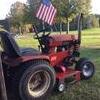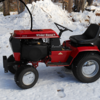Leaderboard
-
in Posts
- All areas
- Markers
- Marker Comments
- Marker Reviews
- Articles
- Article Comments
- Article Reviews
- Classfieds
- Classified Comments
- Classified Reviews
- Wiki's
- Wiki Comments
- Wiki Reviews
- Blog Entries
- Blog Comments
- Images
- Image Comments
- Image Reviews
- Albums
- Album Comments
- Album Reviews
- Files
- File Comments
- File Reviews
- Posts
-
Custom Date
-
All time
November 28 2011 - November 27 2024
-
Year
November 26 2023 - November 27 2024
-
Month
October 26 2024 - November 27 2024
-
Week
November 19 2024 - November 27 2024
-
Today
November 26 2024 - November 27 2024
-
Custom Date
03/21/2024 - 03/21/2024
-
All time
Popular Content
Showing content with the highest reputation on 03/21/2024 in Posts
-
15 points
-
11 points@Bens vintage tractors Maybe Ben could make a deal for the entire lot or a large part depending upon what's there. Appears your grandfather might have held on to some just a bit too long and didn't store them very well. but there's some value, probably more than scrap in the parts to keep our older machines going. Even at scrap cost, it's better to recycle them back into the WH hobby to be used again rather than end up as chinese junk trinkets.
-
10 pointsBringing in the sheaves The practice of binding and tying cut grasses or grain stalks into sheaves is a step in the harvesting process. In earlier times, farmers cut grass and grain by hand using or scythes. Once cut, the stalks were bundled and bound into sheaves; the sheaves were bundled together upright to dry. These larger bundles, made up of sheaves, were called "shocks." When dry, the sheaves could be threshed. The seed was collected for food and the remaining straw was used as bedding for livestock. Once the grain had been cut, sheaved, and stacked for drying a crew of men with pitchforks would pitch the sheaves onto a wagon for transportation to be thrashed. After the bundles were dry, they were stored in a barn or a carefully built stack, and capped with prairie grass to shed rain until threshing time. Once the threshing machine was invented the sheaves needed to be arranged with all the grain heads oriented in the same direction to allow the thrasher to remove the grain from the stems. Prior to the trashing machine it was yet another labor-intensive operation to remove the grain from the stem. This is also incorporated into the modern combine.
-
7 pointsThanks for bringing back the memories Richard. I lived with my Grandad where we farmed about 25 acres mainly growing corn. One year he planted around 10 acres in wheat. I was probably 12 years old at the time and just big enough to swing the cradle. He showed me how to cut and lay the wheat.in rows. Then scoop an armfull and tie it into a sheave with a handfull of the straw. The process was similar to this video except we separated and knotted the handfull of straw into two sections doubling it's length. With this longer length, we could bundle and tie a much larger sheave than shown in this video. Thankfully Pappy only planted wheat this one year. I remember feeling I was trying to empty the ocean with a teacup as I started to cradle that ocean of wheat.
-
7 pointsWe do have a vendor that deals in used Wheel Horse parts and would be likely to make an offer on the whole lot. Give Lincoln a phone call and let him look at the pictures to get some idea of what he could offer. Here is a link with his phone number. https://www.a-ztractor.com/
-
6 pointsHello everyone! And thanks for the wealth of knowledge here! I hope it continues for years to come, as I am just about to purchase my first horse. I had planned to buy a B 80 that I came across on Craigslist, since I am not on fb ( where everyone seems to sell everything now...) so I had plans to pick up the B80 8 h.p Koehler this weekend after doing lots of research which always led me here, so I finally decided to join... I was told though, if I wanted to do much tilling to try n find at least a 12 horse so I browsed marker place on the wife's account and came across a beautiful C160 16 h.p Koehler for about the same money... so I changed my plans and made a deal to pick it up this weekend.... I don't know a lot of ppl with knowledge or history of wheel horses, so any opinions would be cool to have.... lmk if I am making the right choice... and I will update when I officially become a newbie Sunday! Looking forward to it.... I just plan to mow some... plow a garden eventually.. when I get the attachments.. but for now, I will enjoy pulling the kids around in a wagon.... just maintain a "mini farm"... 5 acres... thanks in advance and sorry for the long post.. I know you like pics and im not sure if these sellers are already on here so I apologize for posting your horse if you are....the first pic is the 8 h.p. B 80 and second is the C160
-
6 pointsAnd I see Mr. McMullet, wearing his Safety-approved Flippity-Flops in the video.....
-
5 pointsLearning to swing that grain cradle at 12 actually was good training for my first professional job where I paid into the social security system. Our township mowed all the road berms with the scythe in the summer and cleared the snow from many roads with shovels in the winter. I was employed by Southampton Township for a couple years doing this work starting at $0.67/ hour. The summer mowing work was hot and nasty with green briars and ground hornets. The winter work was better. We just hand shoveled the deep drifts where the plows could not push through.
-
5 pointsYou stick around here long enough, and maybe we can convince you to get one or two going for yourself! I have found most often they are worth more in my garage than they are in my pocket.
-
5 pointsMy dad @TonyToro taught me how to weld today on our new to us trailer! I thought I did a pretty good job and surprised myself! 73266574965__28848E1B-32CA-4DCD-BC90-07C24ADD5F17.mov
-
4 pointsHopefully this is the right place. My grandfather had a pretty extensive collection of wheel horse tractors and I am looking to get rid of them. My main question is are they worth anything beyond scrap value? No real clue about the condition these things are in besides what you can see from the pictures. Pretty sure some of them kinda worked about 10 years ago though.
-
4 points
-
4 pointsI've picked a very small amount of cotton as a kid, that wasn't any fun either.
-
4 pointsI though the potato farm was rough.....that wheat harvest is a big deal by hand.
-
3 pointsHow does your garden grow? Cold season business is thriving. Planted a few warm season. Oaks are leafed out and we are mired in pine pollen so that should be fine however it is a little early.
-
3 pointsI think you have the wrong band. Hole should be on the left. A double hole band is needed, or try drilling another hole.
-
3 pointsMy Loader tractors our a Diesel Compact and a Diesel Garden tractor and a Gasoline air cooled Briggs
-
3 pointsI have 3 loader tractors currently: 1 compact tractor with Power steering OEM loader, 1 Garden tractor with Power steering OEM loader, 1 Garden tractor with Manual steering, and a Kwik-way loader (which gets used the least for heavy loader work due to the lack of power steering)
-
3 pointsKiwk-Way Loaders were probably the best aftermarket Loader. 87 416-8 horse. I hope You have more than one tractor, Just because most of these Pump driven mounted Loaders end up making the tractor a more full-time loader tractor. Because changeover is not very fast compared to a tractor that has its own on-board Hydraulic system to power the loader, as most of those tractors also have a walk-on-walk-off loader.. I wish Kwik-way had also made and aftermarket power steering kit for the Wheel Horse tractors like Brantly did for several tractor brands in the 1970s and early 1980s
-
3 pointsHad a potato farm a few miles away, he would hire every kid he could find for spring planting and late summer harvest. Never been as dirty in my life as I was after a day on the potato farm. The soil was a black sand and we had to hose off before coming into the house. The potato harvester would dig under the row and lift the potatoes getting most of the soil off and then lay them in a row on top of the ground. We would ride on a two row skid laying down picking up the potatoes as we went along. The potatoes would be put on a troth and a person on the back would bag them from the troth. As I remember it he had five or six of these setups and we would start early in the morning and quit about eight at night. Hard work but he paid us well and his wife always fixed us a great lunch.
-
3 pointsit’s actually corrugated and perforated drain tube my guess is one machine doesn’t have the power or traction to pull the plow straight, but they both pull together well The muck alone I imagine cannot be farmed. It looks like they compacted about 18-24” of sand atop the muck, then they plow it under. It adds a stable base and proper drainage, since the water table is so high.
-
3 pointsI still have the scythe my maternal Grampa used on his own land somewhere around a bajillion years ago. By the time I was a young 'un in the 70s he'd been mechanized for many years. With his slight guidance I taught myself how to properly swing a scythe as a teen, simply out of curiosity. I remember it being fairly easy on good flat ground but I only did a VERY small area. Whippin' that all day would've been beyond my endurance even then. Huge respect for the manual means of harvesting.
-
3 pointsit would be impressive to see, but I’d like the little guys to get more than 2 passes on the 100 acres!
-
3 pointsEndeavor to keep it that way. Best and friendliest advice is right here. Yes beware of dinguses sporting mohawks and tilling in flip flops tho... A C-160 in hydro or gear jammer is a bucket list tractor around here. You can till with a hydro once you get the feel for it. B-80 great for chore work. We are all amazed what a eight can do! I field plow with mine. In other words get both!
-
3 pointsI bought the PF Engineering plans a few months ago with the intent of building a FEL for my 522xi. I have a plan in place and I'm ready to go buy the steel I need for my subframe as soon as I get a free 5mins. The plans have been helpful, but my only complaint is that you get one set of paper plans and notes. It's a shame they haven't improved to watermarked PDFs or something. That being said.....Between the plans and the people/resources here that have already built or refurbished a FEL on similar tractors, I believe that it is all very doable. I scoured FB marketplace and CL for months looking for a used one that I could adapt. Most of them had OK steel but the hydraulics were usually all trashed (which is the expensive part of the build). I found a few that may have worked, but the cost was about the equivalent of building my own and I think the real end goal of what I want is to have the experience of building it myself. Best of luck on your build. Make sure to take pics and share as you go
-
3 pointsOne of my uncles bought a pull behind John Deere combine that had its own engine about the time I was born so I never experienced swinging a cradle and tieing sheaves. I can remember seeing others using a horse drawn reaper that pushed the cut stalks off into small piles and they had to be hand tied.
-
3 pointsAbsolutely excellent! Welding (metal working in general) is a skill that has great value in many ways. Not the least of which is the ability to repair your own Herd of Wheelhorses, and their implements. Also, the ability to make your own implements tools accessories etc. The possibilities are endless. In a much greater scheme of things - there are many types of hands on skill sets that are becoming more rare. Adding to the list of your own abilities will be extremely helpful for the rest of your life.
-
3 pointsGreat you learn it, another one who was able ti fix things instead just trash and buy new. In the nearer future you will become an extremely wanted Guy. To find good craftsmen will become harder and harder.
-
3 pointsYou might find a gear drive is best for farm chores, plowing, etc. It’s not easy to rototill with only 8 hp, but the low range would be a benefit.
-
3 pointsWestern part of the Tar-Heel-State is looking great too. Our favorite restaurant has outside dining and it was fully occupied at lunch today.
-
3 points
-
2 pointsI feel your pain on the lack of power steering on the 520-H with forward swept front axle and power steering it's bearable .That was another reason for putting it up for sale. Went another route, diesel tractor with power steering.
-
2 points
-
2 points
-
2 pointsI haven't tried that one. I have a Toro dealer close by. Will check it out. Thanks Marv
-
2 pointsAll good points, thanks Pete. On my retirement, I have time to do things carefully and methodically. You seem like you have that attitude. I work with friend a couple hours a day. He's 75, and been building\restoring exotic engines for 50 odd years. Now we have fun with whatever we want. V6 garden tractor, turbine power Jacobsen, and on and on. He teaches me patience. You need a lot restoring these tractors!
-
2 points
-
2 pointsTrina does all the heavy lifting, disassembly, painting and assembly. You trying to lighting her work load?
-
2 pointsI'd vote - Not Obviously it wasn't too hard to find because it was right in with the collection of manuals. LOL
-
2 points23x9.50 tires, 2 sets. Bead sealer is evident, but they were all holding air when I dismounted them. $25 for the Carlisles and $15 for the Deestones. Both sets are comparable size to each other!
-
2 pointsThanks guys for your help after reading the manual again I feel better about timing the engine. also I have decided to leave the blance gears out. So therefore all I have to do is line the long mark on the crankshaft with the dot on the cam. thanks CNC
-
2 pointsAgreed but still... some must die so others can live. The GT 14 & C-160 look to be saveable. Check out the little red riding black hood Sylvia. @SylvanLakeWH Just makes a guy wonder if some didn't leave the factory red. I forgot to mention when I posted this one awhile back that no evidence of this one being re-painted.
-
2 pointsThese Kwik-Way loaders show up for sale once in a while used. This one pictured was on a brand new late model 520-H that the owner passed away. His widow called the WH Dealer to buy back the complete package, tractor, loader and weight box with 30 hours on it. It was never mowed with. I was fortunate to get a call from the dealer asking if I was interested. My response was when can you deliver it. Served me well for light duty for many years and had it on both 520's , 417-8 and a C-165. It was sold to a member on Red Square. Only reason I sold it was that I needed a larger, heavy duty machine for the new property. Good Luck in your search @87 416-8 horse
-
2 points
-
2 pointsDefinitely worth more than scrap! Doubt you will find someone to buy it all as one lot. Most likely would need to sell them off individually.
-
2 points
-
2 pointsI used to work at a place that made the lower front handle for those big rolling bins. Ours were solid pultruded fiberglass rods, but you also often see galvanized steel tubing there too. The truck grabs that handle to heft the bin and its contents - whether they are lightweight packing material or a big block V8 car engine or a load of gravel - and dump it into the truck. They’re incredibly strong. Amazingly, we made 6000 of those handles. Per day. Let that sink in. That’s over 1 million per year. The company we supplied them to was only one of several manufacturers of those bins in the US. And, again, they also used steel handles on other models so our 6000 per day was a drop in the garbage bin so to speak. I was talking to one of their engineers about why they needed to be so strong. He related the car engine and gravel stories I mentioned above. After being responsible for making so many of these containers’ handles and knowing that real engineering went into them I decided I liked these big cans. 👍🏻 My neighbors fought to get those bins used by our trash collectors for years. Prior to this we were on our own and could put either a trash can or loose bags out for weekly collection. Apparently the trash service finally got new trucks so offered the option to the HOA. They eagerly bit on it as a convenience and they made arrangements on everyone’s behalf to all pay a flat rate for weekly trash collection and biweekly recycling. So, one day two of those 96 gallon bins showed up in my driveway. One for trash, the other for recycling. I wasn’t thrilled, but it really isn’t a big deal. This did, though, present a few annoyances for our household… First, our neighborhood covenants don’t allow anybody to leave their trash cans outside overnight. So they have to stay in the garage. And 96 gallon cans are huge. And there were TWO of them. So, a little garage reshuffling and a much needed cleanup of things I guess I didn’t need to own anymore resulted. Work I didn’t relish, but no big deal. The cans were nicely nestled in the front of the garage where the workbench used to be. After a few weeks the neighbors started to complain about the cans and their size on the neighborhood’s Facebook page. Many appealed to the HOA board to let us keep them outside. Those efforts failed. So the cans so many had clamored for became an albatross for some. Whodathunk? My wife saw that the trash collection service offered smaller cans instead if anybody wanted to swap them out. That suited us well so we exchanged our twin 96 gallon behemoths for a pair of 50-ish gallon cans (smallest size they offer). These are MUCH better but are still pretty darn big. But better. 👍🏻 Part of the same announcement was that if anyone had found that a single 96 gallon trash can or recycle bin wasn’t large enough for their family that they could have a second. Or third. Or as many as they wanted for no additional cost. My wife and i both expressed the same amazement to each other that one gigantic trash can might not be enough, but at least it was a good effort to please customers. Second, part of the deal between the trash collection service and the neighborhood HOA was supposed to save everyone money on their compulsory trash collection bill. Now we all pay the same flat fee for our trash collection. That’s kind of nice I suppose for budgeting and whatnot. How’s that a problem? Before the flat-rate, Noah’s ark-sized bins showed up we used to all pay a small fee to the trash service and then pay $4.75 per bag or trashcanful that we threw away. This was executed by buying stickers to put on your trash. No sticker, and they’d pass over your junk. Sort of a reverse lamb’s blood/passover thing. (Wow, two bible references in the same paragraph!) I loved the sticker system. I’d stick one on our trash can and they’d pick up the trash. Some weeks we didn’t have enough trash to bother so I’d save it for the next week. And they had a nice chart made that showed how many stickers you needed to dispose of a big item like a washing machine, patio set, or a mattress. It was brilliant. But apparently costly for some who had a lot of trash every week. Third, I had bought a ton of stickers preemptively when the price was still $3.5 (or whatever it was) apiece before the last price increase. I still had a stack of them left over when that process was usurped by the Goliaths (number 3!) now lurking in my garage. My mistake for planning ahead. Anyway, I am less of a fan of the giant bins than I used to be. 👎 One side effect i think i am observing is that I think we are generating more trash in our neighborhood now. Before, when there was a direct cost associated with not managing a waste stream, I think we were a little more conservative with what went in the trash. With these big containers it’s like a bottomless pit to throw trash into. At least my stack of unused stickers fit easily in the bin. Steve
-
2 pointsUnfortunately there's a worn out "isavetractors" carb on here. No worries whatsoever. I have a freshly rebuilt 1970 Kohler carb from the Charger Hydro attempt. Excellent use for that!
-
2 points
-
2 pointsIf your entire deck is tilted, I would look at the tire pressure and the diameter of the rear tires on the tractor. The rear wheels on the deck need to also support the deck properly. Look at the size , bearings and support brackets of these deck wheels. With the deck lowered on a flat hard surface, measure the height of the blade tips with the blades positioned left to right. They should all be equal. With the blades positioned Front to rear, the blade tips should be 1/8" less than the rear. If the individual blade cuts are uneven, then you need to look at the spindles, bearings, bent or warped deck shell.

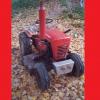
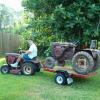
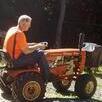
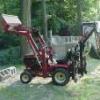
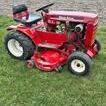



.thumb.jpeg.8bdd6995142db7fbcf4df2d7b452df33.jpeg)



